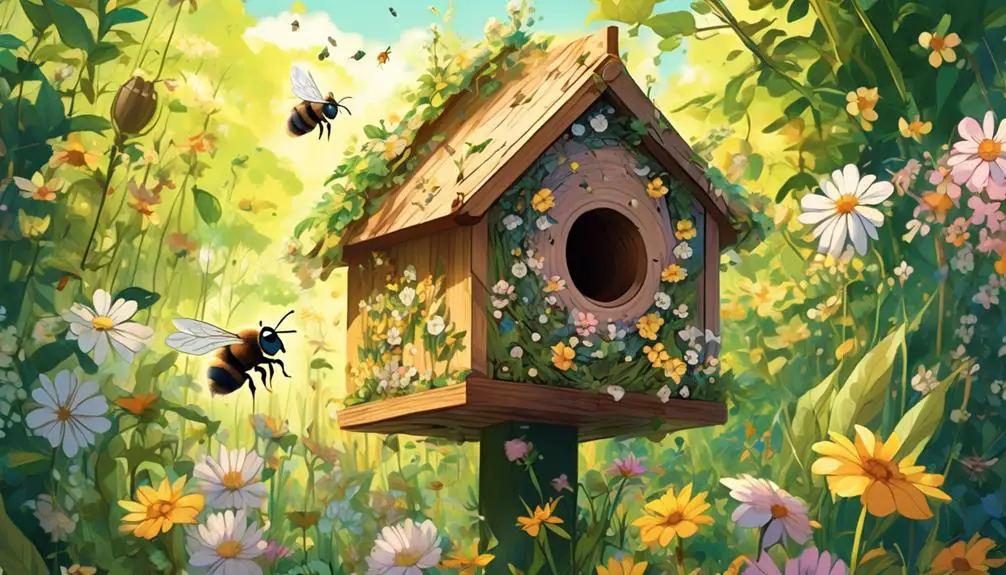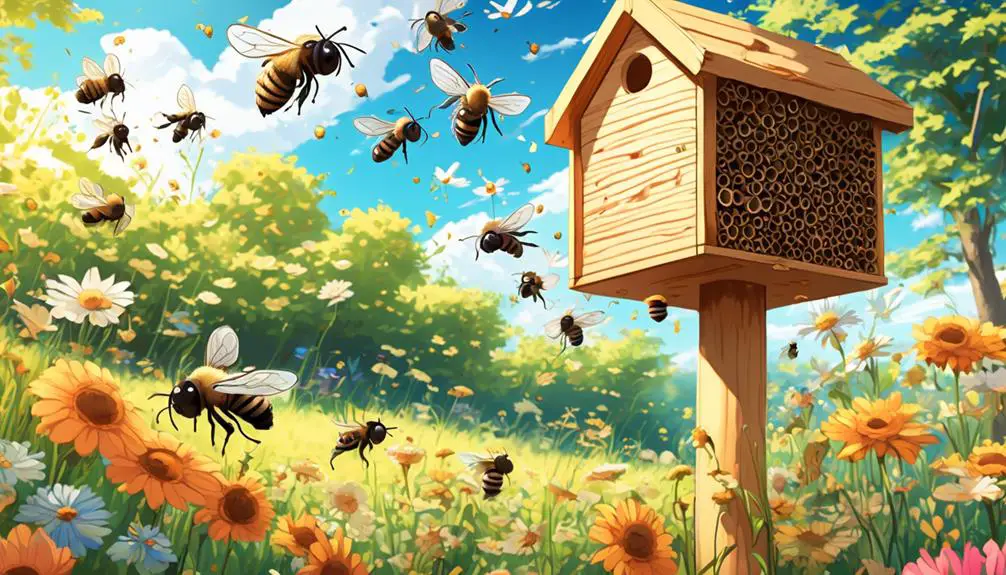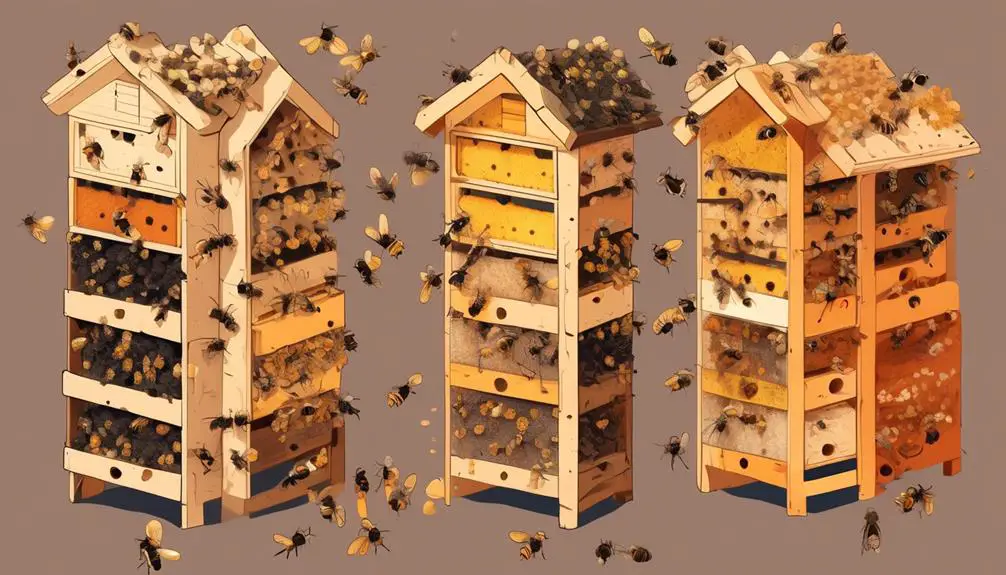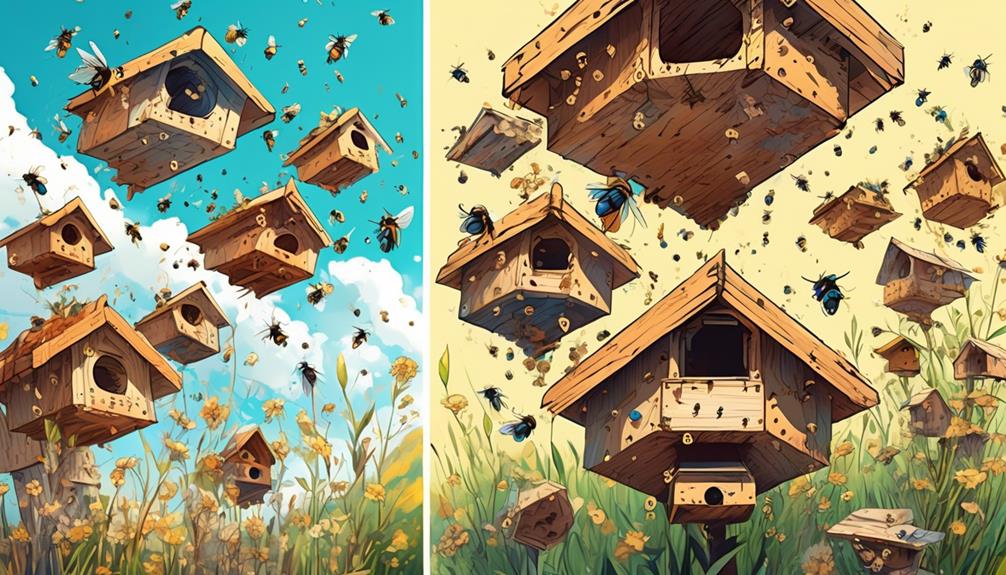Uncover the ideal number of mason bees per house to maximize pollination without causing competition, in this intriguing guide.

How Many Mason Bees per House?
Did you know that a single mason bee can pollinate as much as a hundred honeybees? This small but mighty creature is a boon to our ecosystem, particularly for gardeners and farmers.
However, you may wonder, how many of these industrious insects should you ideally have in one house? It's not as simple as you might think. There's a delicate balance to maintain, as too many could lead to competition for resources, and too few might not provide the pollination you need.
So, what's the magic number? Stick around, and you'll find out.
Key Takeaways
- The ideal number of Mason Bees depends on the size of the space and abundance of flowering plants.
- Smaller gardens may only need 50 to 100 Mason Bees, while larger areas could benefit from hundreds or even thousands.
- A ratio of two bees per square yard of flowering plants is recommended for effective pollination.
- Mason Bees prefer a diverse array of flowers for a steady supply of nectar and pollen.
Understanding Mason Bees

To fully grasp the nature of Mason Bees, it's crucial to delve into their unique biological characteristics and behavior patterns. Unlike their honeybee counterparts, Mason Bees are solitary creatures. They don't live in hives, and each female is fertile, setting up their own nests in hollow reeds or holes in wood.
These bees are named for their masonry-like habit of using mud to close off their nests. Each nest contains several cells, each housing an egg, pollen, and nectar for the larva to feed on. They're also non-aggressive by nature. You might find it fascinating to know that they can't sting unless trapped or squashed, making them safe around children and pets.
Mason Bees play a crucial role in pollination. They're more effective pollinators than honeybees, as they carry pollen on their abdomen and it falls off easily as they move from flower to flower. Understanding these characteristics can greatly aid in your beekeeping efforts. Knowing how they operate as individuals and their nesting habits can inform your decision on how many Mason Bees to house.
Importance of Mason Bees

Given their unique characteristics and nesting habits, you might now appreciate why Mason Bees are remarkably critical to our ecosystem. These solitary bees play a crucial role in pollination, a process vital for the reproduction of most flowering plants. Unlike honeybees that tend to focus on a single type of flower during each foraging trip, Mason Bees are less selective, leading to more efficient cross-pollination.
Their solitary nature also provides an ecological advantage. Since they don't live in colonies like honeybees or bumblebees, they're less likely to transmit diseases or parasites to one another, promoting healthier bee populations.
Their nesting habits are beneficial too. As they don't excavate their nests, but instead utilize existing holes and crevices, they cause minimal damage to structures and can even help aerate compacted soil. Furthermore, they're non-aggressive, posing little threat to humans.
Ideal Number of Mason Bees

Determining the ideal number of Mason Bees for your garden or orchard depends on several factors, including the size of your space and the variety and abundance of flowering plants. On average, a smaller garden might only need around 50 to 100 mason bees, while larger areas could benefit from hundreds or even thousands.
Consider the bee-to-plant ratio. For effective pollination, you'll need about two bees per square yard of flowering plants. Mason bees aren't particular about plant types, but they do prefer a diverse array of flowers. It's vital to ensure there's a steady availability of nectar and pollen throughout the bee's active season.
Also, think about the nesting space. Mason bees need suitable cavities to lay their eggs. If you're using a bee house, it should have enough tubes or holes for the number of bees you're inviting. Remember, each female mason bee can lay up to 36 eggs in her short life.
Balancing the Mason Bee Population

Regularly monitoring and adjusting your Mason bee population is essential for maintaining a healthy and productive ecosystem in your garden or orchard. It's not just about having a high number of bees; it's ensuring that the population is sustainable and balanced. Too many bees in one house can lead to competition for resources, while too few can result in inadequate pollination.
A balanced Mason bee population ideally allows for efficient pollination without over-stressing the bees or the ecosystem. You'll need to keep an eye on three key factors: the number of bees, available nesting spaces, and the abundance of local flora. Here's a quick guide:
Factor | Ideal Condition | Sign of Imbalance |
|---|---|---|
Number of Bees | Stable, increasing slowly | Rapid increase or decrease |
Nesting Spaces | Enough for all bees | Overcrowding or empty nests |
Local Flora | Diverse, abundant | Scarcity or monoculture |
Maintenance of Mason Bee Houses

Caring for your Mason bee house involves not only ensuring a stable bee population but also performing regular maintenance tasks to keep the house in optimal condition for these hardworking pollinators. The primary goal is to create an environment that's conducive to their survival and productivity.
Firstly, you need to monitor and manage pests and parasites. Regularly inspect the bee house for signs of mites, fungi, and other potential threats. If you notice any, you'll have to clean the house thoroughly using a mild bleach solution.
Secondly, ensure the house is well-ventilated and dry, as moisture can lead to the growth of mold and fungus, detrimental to the health of the bees. You may need to relocate the house if it's in a damp location.
Lastly, the bee house should be replaced every two to three years. Over time, the wooden holes can become rough and splintered, causing harm to the bees. Updating the house also reduces the risk of disease build-up.
Proper maintenance of Mason bee houses is a critical and ongoing task that requires vigilance, analytical observation, and timely interventions. It's all worth it though, for the sake of our industrious, pollinating friends.
Conclusion
In conclusion, you've learned that mason bees are vital for our ecosystem. Ideally, you'd want about 6-7 bees per tube in your bee house. However, balance is key.
Too many can overcrowd and stress the colony. Regular maintenance of your bee house ensures a healthy environment for them to thrive.
Understanding and addressing the needs of these tiny pollinators can significantly contribute to the conservation of our biodiversity.



